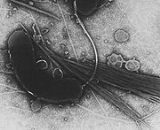
Vibrio cholerae
Overview
Gram-negative
Gram-negative bacteria are bacteria that do not retain crystal violet dye in the Gram staining protocol. In a Gram stain test, a counterstain is added after the crystal violet, coloring all Gram-negative bacteria with a red or pink color...
, comma-shaped bacterium. Some strains of V. cholerae cause the disease cholera
Cholera
Cholera is an infection of the small intestine that is caused by the bacterium Vibrio cholerae. The main symptoms are profuse watery diarrhea and vomiting. Transmission occurs primarily by drinking or eating water or food that has been contaminated by the diarrhea of an infected person or the feces...
. V. cholerae is facultatively anaerobic
Anaerobic
Anaerobic is a word which literally means without oxygen, as opposed to aerobic.In wastewater treatment the absence of oxygen is indicated as anoxic; and anaerobic is used to indicate the absence of a common electron acceptor such as nitrate, sulfate or oxygen.Anaerobic may refer to:*Anaerobic...
and has a flagella at one cell pole. V. cholerae was first isolated as the cause of cholera by Italian anatomist Filippo Pacini
Filippo Pacini
Filippo Pacini was an Italian anatomist, posthumously famous for isolating the cholera bacillus Vibrio cholerae in 1854, well before Robert Koch's more widely accepted discoveries thirty years later....
in 1854, but his discovery was not widely known until Robert Koch
Robert Koch
Heinrich Hermann Robert Koch was a German physician. He became famous for isolating Bacillus anthracis , the Tuberculosis bacillus and the Vibrio cholerae and for his development of Koch's postulates....
, working independently thirty years later, publicized the knowledge and the means of fighting the disease.
V.
Unanswered Questions

